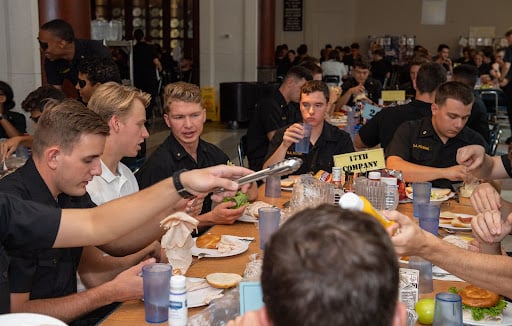
There’s nothing that brings people together like breaking bread and sharing a meal. When you’re bringing more than 4,400 midshipmen together, that’s a lot of bread and a lot of meals. In the Naval Academy dining hall, King Hall, this feat is performed three times a day. It’s run like a ship because they’re preparing the future Navy for the rhythm of mealtimes aboard a ship. Also, how else can you feed that volume of people so efficiently?
King Hall is so interesting that the industry trade publication Foodservice Director featured their story. Let's go behind the scenes to see how they accomplish this gargantuan task three times a day!
First, the facts:
- 55,000 square feet
- 392 tables
- 13,500 meals each day
- Monday - Friday has “mando meals” (mandatory) for breakfast and lunch; dinner is optional (usually 2,000 attend).
- Midshipmen have 25 minutes for breakfast and lunch; dinner is a 2.5 hour window.
- The scullery washes 40,000 pieces of silverware, dishes, and glassware each meal.
- Midshipmen consume:
- An average of 1,000 gallons of milk per day.
- Two tons of meat per day.
- One ton of green vegetables per day.
- Two tons of potatoes per day.
- 1,200 loaves of bread per day.
- 720 pies per day.
- 100 pounds of peanut butter per day.
- 300 gallons of soft serve ice cream and fruit smoothies per day.
The Naval Academy Dining Hall Kitchen
The big brass bell rings in the center of the hall with military precision, signifying it’s time for everyone to sit down simultaneously. Hundreds of workers orchestrate the meal, many of whom have been there for decades, and they all love interacting with the midshipmen. These workers depend on the right tools to get the job done: seventeen combination ovens to cook 2,000 pounds of shrimp, 3,000 hamburgers or 2,500 pounds of chicken, each in one hour. The galley uses nine steam-jacketed kettles to heat 1,000 gallons of soup or cook two tons of pasta.
Thirty mobile serving carts keep trays of prepared food at the proper temperature until serving time. Each cart is rolled out to 20 tables, and each table receives three to four pans of hot food to share family-style. Midshipmen can get additional vegetables from the server. There are also large salad bars and protein bars stationed in each of the three wings, and large wire bins offer up snacks.
The staff members in the Academy's Midshipmen Food Service Division pay careful attention to every detail and strive for a high-quality experience every time. The food is healthy, fresh, nutritionally sound and of a great variety. The Naval Academy Dining Hall provides at least two entrees at each sitting. These meals are carefully planned to provide a nutritionally balanced 3,500-4,000 calories per midshipman each day, for a government-authorized individual ration allowance of $20.35 per day. The meat must be U.S. Choice, and the vegetables are Grade A Fancy. All breads and pastries are freshly baked each day.
What’s on the Naval Academy Dining Hall Menu?
Breakfast: Midshipmen have their choice of eggs (fried/scrambled), a grain such as pancakes, waffles, or french toast, broiled bacon, broiled hash browns, fresh fruit, more than eight varieties of ready-to-eat cereal and freshly baked donuts, pastries or bagels. They can also enjoy coffee and hot chocolate, and orange juice and condiments are on the table when they arrive.
Lunch: Generally, lunch takes the form of a hand-held sandwich-type meal plus a daily vegetable. Dessert is laid out on center tables along with salad bars, protein bars (many times featuring tuna, chicken, and quinoa) and bread bars. Condiments and dressings are placed on each table.
Dinner: This optional meal is buffet style, with a main entree of chicken, beef, or fish and a vegetable and potato or rice dish. Since dinner is not mandatory, plebes can also order delivery from a service like Grubhub or DoorDash, and upperclassmen can head to Annapolis or other Yard establishments like 1845 Coffee (or even grab food from a food truck), liberty permitting.
While it’s definitely not your typical college dining hall, you’ll find familiar foods, with the most popular menu similar to those at civilian schools. Meals like buffalo chicken sandwiches with cheddar muncher tater tots, hamburgers, mac and cheese, tacos, burritos, and “Flapsticks” (sausage on a stick dipped in blueberry batter and baked, served with butter and syrup) are perennial favorites. “Cannonballs and hard sauce” is ranked as a top dessert; it’s an apple turnover dessert with thick cake icing sauce. Like other college students, the midshipmen’s favorite staple is peanut butter.
King Hall hosts several special events throughout the year that have also become tradition:
- Welcome Back Night: Different vendors and food trucks support the midshipmen.
- Brigade Halloween Night: This is best paired with the Halloween All Saints Day Organ Concert around the same time!
- Thanksgiving: A traditional holiday meal served family style.
King Hall Is a Special Place
Constructed as part of the original Academy in 1907, it was named for Fleet Admiral Ernest J. King from the Naval Academy Class of 1901, who served as Chief of Naval Operations during WWII and was one of only four men to hold the rank of Fleet Admiral. It’s one of the few places on the Yard where the entire Brigade can be seated together.
Experience the Yard
Come see the Naval Academy, where history is made every day. Your USNA tour, dining, and purchases on the Yard help fund the extracurricular activities, cultural arts, music, theater, and club sports that mean so much to the midshipmen. Visit today and experience the magic of the Yard in person!






